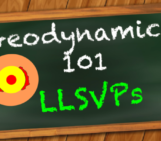
Apart from Earth, there are a lot of Peculiar Planets out there! Every 8 weeks, we look at a planetary body worthy of our geodynamic attention. This week Richard Ghail, lecturer in Engineering Geology at Imperial College London in the United Kingdom, discusses Earth’s sister: Venus.
 Geologists have long held the view that they only have the results of one experiment: Earth. The growing list of Earth-like planets around other stars (exo-Earths) means that such a view is no longer valid, even if we have limited knowledge of those worlds. Surprisingly, perhaps, our own Solar System boasts two exo-Earths: and the other one is not Mars, as you might think, but Venus. Our nearest planetary neighbour is also the most similar to Earth: at about 80% of its mass and 95% of its radius, and orbiting arguably within our Sun’s habitable zone, Venus would be recognised as an Earth-like exoplanet if it were in orbit around another star. Yet the results of these two experiments could not be more different: Earth may not quite be Eden, but Venus is certainly the closest place we know to hell. Its dense global shroud of sulphuric acid clouds hides a surface on which a person would be simultaneously roasted (at 450°C), crushed (at 90 atmospheres pressure), poisoned and asphyxiated (its atmosphere is 95% CO₂), and corroded (not by sulphuric acid, which decomposes under the extreme conditions, but by HCl and even HF!). The armoured Soviet Venera landers survived only a couple of hours on the surface, but still managed to return tantalising pictures of a barren rocky landscape bathed in an orange light.
Geologists have long held the view that they only have the results of one experiment: Earth. The growing list of Earth-like planets around other stars (exo-Earths) means that such a view is no longer valid, even if we have limited knowledge of those worlds. Surprisingly, perhaps, our own Solar System boasts two exo-Earths: and the other one is not Mars, as you might think, but Venus. Our nearest planetary neighbour is also the most similar to Earth: at about 80% of its mass and 95% of its radius, and orbiting arguably within our Sun’s habitable zone, Venus would be recognised as an Earth-like exoplanet if it were in orbit around another star. Yet the results of these two experiments could not be more different: Earth may not quite be Eden, but Venus is certainly the closest place we know to hell. Its dense global shroud of sulphuric acid clouds hides a surface on which a person would be simultaneously roasted (at 450°C), crushed (at 90 atmospheres pressure), poisoned and asphyxiated (its atmosphere is 95% CO₂), and corroded (not by sulphuric acid, which decomposes under the extreme conditions, but by HCl and even HF!). The armoured Soviet Venera landers survived only a couple of hours on the surface, but still managed to return tantalising pictures of a barren rocky landscape bathed in an orange light.
A geodynamic surprise: Catastrophe or not?
NASA’s Magellan mission (1989-1994) revealed that geodynamically too, Venus was a surprise. A wealth of volcanoes, rifts and mountains cover its surface but there is little evidence for the spreading ridges and deep trenches that characterise plate tectonics on Earth. More perplexing was the realisation that the 950 or so impact craters – implying a youthful 500 Ma average age – were distributed apparently at random. Had the whole planet been somehow catastrophically resurfaced in one go, half a billion years ago? As strange as it might sound, there appeared to be good reasons to think so: that 450°C surface temperature is enough to stop the crust subducting, effectively shutting down plate tectonics. Without that safety valve, the interior of Venus must be getting ever hotter at the same time that exterior cools and thickens the lithosphere. Such a situation is inherently unstable and calculations showed that Venus should ‘blow its top’ every 500 Ma or so – explaining both the lack of plate tectonic features and the crater distribution. The Venus enigma was solved.
Or was it? The theory divided the community into bitterly opposed sides for the next decade or more. One group could see a global sequence of events in its geological features that seemed to confirm the theory; while the other could see an array of geological complexity at odds with it. ESA’s Venus Express mission (2005-2012) focussed on the planet’s atmosphere but it revealed a remarkably dynamic and changeable system that must somehow reflect geodynamic activity below. It even found tantalising hints of recent volcanic activity. Understanding both the geological evidence and the crater distribution turns out to depend on the very thing that set Venus apart from Earth: its extreme surface conditions. The high temperature not only makes the crust buoyant, but weak, especially so at about 10 km depth, where it is able to shear relative to the mantle below. In this new geodynamic view, plate tectonics does operate on Venus much as it does on Earth, but under 10 km of crust, not 5 km of ocean (Ghail, 2015). As well as explaining the large-scale features of Venus, including its geoid, calculations show that this subcrustal rejuvenation, as it is called, is able to maintain the heat balance on Venus). No catastrophic events are required.
If the crater distribution is not the result of a global catastrophe, what caused it? Mechanically, the basaltic crust of Venus behaves much like Earth’s granitic continental crust, and is similarly broken into many small plates, or terranes, on the order of 500 to 1500 km across, characterised by low strain interiors and highly deformed margins, similar to terrestrial continental blocks. On Earth these terranes are driven by far-field plate tectonic stresses but on Venus they are driven by subcrustal rejuvenation stresses that jostle the terranes against one other but do not move them far across the surface. Impact craters are preserved in terrane interiors but rapidly destroyed at their margins, so that the average crater spacing is similar to the size of terranes. The preserved terrane-interior craters are only destroyed when the terrane is itself destroyed, most likely by interaction with a subcrustal plate boundary (rift or collision), which by inference is something that occurs on average every half billion years. This new geodynamic understanding refines our appreciation of how the geochemistry and geomechanics of the outer few kilometres of the planet profoundly influence stagnant-lid behaviour, promising new insights into early-Earth geodynamics and the nature of newly-discovered exo-Earths.

Welcome to hell Venus. I want you to explore it!
Credit: Pixabay
Exploring Venus
So our views of Venus have changed; our Solar System’s second experiment is, geodynamically, rather more similar to Earth than once imagined. Even so, these ideas have yet to be tested, and our nearest neighbour retains many secrets. Almost nothing is known about its interior, its rates of activity, or even how Venus maintains such a hostile atmosphere. A new phase in Venus exploration is called for, and within Europe the most promising is the proposed EnVision mission, which is currently undergoing evaluation by ESA. EnVision will use an advanced Earth Observation heritage interferometric radar to measure and monitor geological activity over a 5-year period and obtain images at up to 1 m resolution – sufficient to locate and track the Venera landers, providing the precise geodetic control needed to measure terrane deformation. A radar sounder will probe the near subsurface and an IR/UV emission spectrometer will map geochemistry and follow volcanic gases from their source to the upper atmosphere. NASA has proposed landers that could probe interior seismicity, and in the future balloons may directly sense cloud chemistry and dynamics. Unlike the Moon and Mars, these missions will be exploring a world that is – in a geodynamic sense, at least – very much alive.
References Ghail, R. (2015). Rheological and petrological implications for a stagnant lid regime on Venus. Planetary and Space Science, 113, 2-9.




